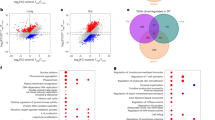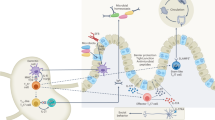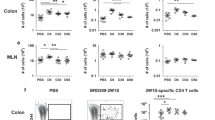Abstract
Interleukin (IL)-17-producing T helper cells (TH17) are a recently identified CD4+ T cell subset distinct from T helper type 1 (TH1) and T helper type 2 (TH2) cells1. TH17 cells can drive antigen-specific autoimmune diseases and are considered the main population of pathogenic T cells driving experimental autoimmune encephalomyelitis (EAE)2, the mouse model for multiple sclerosis. The factors that are needed for the generation of TH17 cells have been well characterized3,4,5,6. However, where and how the immune system controls TH17 cells in vivo remains unclear. Here, by using a model of tolerance induced by CD3-specific antibody, a model of sepsis and influenza A viral infection (H1N1), we show that pro-inflammatory TH17 cells can be redirected to and controlled in the small intestine. TH17-specific IL-17A secretion induced expression of the chemokine CCL20 in the small intestine, facilitating the migration of these cells specifically to the small intestine via the CCR6/CCL20 axis. Moreover, we found that TH17 cells are controlled by two different mechanisms in the small intestine: first, they are eliminated via the intestinal lumen; second, pro-inflammatory TH17 cells simultaneously acquire a regulatory phenotype with in vitro and in vivo immune-suppressive properties (rTH17). These results identify mechanisms limiting TH17 cell pathogenicity and implicate the gastrointestinal tract as a site for control of TH17 cells.
This is a preview of subscription content, access via your institution
Access options
Subscribe to this journal
Receive 51 print issues and online access
$199.00 per year
only $3.90 per issue
Buy this article
- Purchase on Springer Link
- Instant access to full article PDF
Prices may be subject to local taxes which are calculated during checkout




Similar content being viewed by others
References
Korn, T., Bettelli, E., Oukka, M. & Kuchroo, V. K. IL-17 and Th17 cells. Annu. Rev. Immunol. 27, 485–517 (2009)
Langrish, C. L. et al. IL-23 drives a pathogenic T cell population that induces autoimmune inflammation. J. Exp. Med. 201, 233–240 (2005)
Bettelli, E. et al. Reciprocal developmental pathways for the generation of pathogenic effector TH17 and regulatory T cells. Nature 441, 235–238 (2006)
Mangan, P. R. et al. Transforming growth factor-β induces development of the TH17 lineage. Nature 441, 231–234 (2006)
Manel, N., Unutmaz, D. & Littman, D. R. The differentiation of human TH-17 cells requires transforming growth factor-β and induction of the nuclear receptor RORγt. Nature Immunol. 9, 641–649 (2008)
Yang, L. et al. IL-21 and TGF-β are required for differentiation of human TH17 cells. Nature 454, 350–352 (2008)
Hirota, K. et al. Preferential recruitment of CCR6-expressing Th17 cells to inflamed joints via CCL20 in rheumatoid arthritis and its animal model. J. Exp. Med. 204, 2803–2812 (2007)
Merger, M. et al. Defining the roles of perforin, Fas/FasL, and tumour necrosis factor α in T cell induced mucosal damage in the mouse intestine. Gut 51, 155–163 (2002)
Chatenoud, L. & Bluestone, J. A. CD3-specific antibodies: a portal to the treatment of autoimmunity. Nature Rev. Immunol. 7, 622–632 (2007)
Herold, K. C. et al. Treatment of patients with new onset type 1 diabetes with a single course of anti-CD3 mAb teplizumab preserves insulin production for up to 5 years. Clin. Immunol. 132, 166–173 (2009)
Carpenter, P. A. et al. Non-Fc receptor-binding humanized anti-CD3 antibodies induce apoptosis of activated human T cells. J. Immunol. 165, 6205–6213 (2000)
Smith, C. A., Williams, G. T., Kingston, R., Jenkinson, E. J. & Owen, J. J. Antibodies to CD3/T-cell receptor complex induce death by apoptosis in immature T cells in thymic cultures. Nature 337, 181–184 (1989)
Perruche, S. et al. CD3-specific antibody-induced immune tolerance involves transforming growth factor-β from phagocytes digesting apoptotic T cells. Nature Med. 14, 528–535 (2008)
Chatenoud, L., Primo, J. & Bach, J. F. CD3 antibody-induced dominant self tolerance in overtly diabetic NOD mice. J. Immunol. 158, 2947–2954 (1997)
Alegre, M. L. et al. An anti-murine CD3 monoclonal antibody with a low affinity for Fc gamma receptors suppresses transplantation responses while minimizing acute toxicity and immunogenicity. J. Immunol. 155, 1544–1555 (1995)
Bettelli, E. et al. Myelin oligodendrocyte glycoprotein-specific T cell receptor transgenic mice develop spontaneous autoimmune optic neuritis. J. Exp. Med. 197, 1073–1081 (2003)
Annunziato, F. et al. Phenotypic and functional features of human Th17 cells. J. Exp. Med. 204, 1849–1861 (2007)
Reboldi, A. et al. C-C chemokine receptor 6-regulated entry of TH-17 cells into the CNS through the choroid plexus is required for the initiation of EAE. Nature Immunol. 10, 514–523 (2009)
Brown, S. J. & Mayer, L. The immune response in inflammatory bowel disease. Am. J. Gastroenterol. 102, 2058–2069 (2007)
Petitto, J. M., Streit, W. J., Huang, Z., Butfiloski, E. & Schiffenbauer, J. Interleukin-2 gene deletion produces a robust reduction in susceptibility to experimental autoimmune encephalomyelitis in C57BL/6 mice. Neurosci. Lett. 285, 66–70 (2000)
Pestka, S. et al. Interleukin-10 and related cytokines and receptors. Annu. Rev. Immunol. 22, 929–979 (2004)
McGeachy, M. J. et al. TGF-β and IL-6 drive the production of IL-17 and IL-10 by T cells and restrain TH-17 cell-mediated pathology. Nature Immunol. 8, 1390–1397 (2007)
Kohm, A. P. et al. Treatment with nonmitogenic anti-CD3 monoclonal antibody induces CD4+ T cell unresponsiveness and functional reversal of established experimental autoimmune encephalomyelitis. J. Immunol. 174, 4525–4534 (2005)
Khader, S. A., Gaffen, S. L. & Kolls, J. K. Th17 cells at the crossroads of innate and adaptive immunity against infectious diseases at the mucosa. Mucosal Immunol. 2, 403–411 (2009)
Rodriguez-Creixems, M. et al. Bloodstream infections: evolution and trends in the microbiology workload, incidence, and etiology, 1985–2006. Medicine (Baltimore) 87, 234–249 (2008)
Martin, G. S., Mannino, D. M., Eaton, S. & Moss, M. The epidemiology of sepsis in the United States from 1979 through 2000. N. Engl. J. Med. 348, 1546–1554 (2003)
Ochi, A., Yuh, K. & Migita, K. Not every superantigen induces tolerance in vivo . Semin. Immunol. 5, 57–63 (1993)
Soos, J. M., Schiffenbauer, J. & Johnson, H. M. Treatment of PL/J mice with the superantigen, staphylococcal enterotoxin B, prevents development of experimental allergic encephalomyelitis. J. Neuroimmunol. 43, 39–43 (1993)
Chowell, G. et al. Severe respiratory disease concurrent with the circulation of H1N1 influenza. N. Engl. J. Med. 361, 674–679 (2009)
Bettelli, E. et al. Myelin oligodendrocyte glycoprotein-specific T cell receptor transgenic mice develop spontaneous autoimmune optic neuritis. J. Exp. Med. 197, 1073–1081 (2003)
Wan, Y. Y. & Flavell, R. A. Identifying Foxp3-expressing suppressor T cells with a bicistronic reporter. Proc. Natl Acad. Sci. USA 102, 5126–5131 (2005)
Nakae, S. et al. Antigen-specific T cell sensitization is impaired in IL-17-deficient mice, causing suppression of allergic cellular and humoral responses. Immunity 17, 375–387 (2002)
Ye, P. et al. Requirement of interleukin 17 receptor signaling for lung CXC chemokine and granulocyte colony-stimulating factor expression, neutrophil recruitment, and host defense. J. Exp. Med. 194, 519–528 (2001)
Kamanaka, M. et al. Expression of interleukin-10 in intestinal lymphocytes detected by an interleukin-10 reporter knockin tiger mouse. Immunity 25, 941–952 (2006)
Alegre, M. L. et al. An anti-murine CD3 monoclonal antibody with a low affinity for Fc gamma receptors suppresses transplantation responses while minimizing acute toxicity and immunogenicity. J. Immunol. 155, 1544–1555 (1995)
Acknowledgements
The authors would like to thank F. Manzo for expert administrative assistance, L. Evangelisti and C. Hughes for generating embryonic stem cells and chimaeric mice, respectively, J. Stein for initial screening of knock-in mice, T. Ferrandino for assistance with the mouse colony, E. Eynon and J. Alderman for managing the mouse program and A. Lin for assistance with Gene Array analysis. We also thank T. Taylor and G. Tokmoulina for expert help with the FACS sorting and D. Gonzalez for help with the multiphoton microscopy. We would like to thank J. P. Allison for providing the anti-CTLA-4 antibody, F. Waldron-Lynch and J. S. Pober for providing peripheral blood mononuclear cells, and the NIH Tetramer core facility for providing the tetramers. W.O. was supported by a fellowship from the National Multiple Sclerosis Society. S.H. was supported by the DFG (HU 1714/1-1) and by a James Hudson Brown–Alexander B. Coxe Fellowship. E.E. was supported by the Spanish Ministry of Science postdoctoral fellowship and by a James Hudson Brown–Alexander B. Coxe Fellowship. R.A.F. is an Investigator of the Howard Hughes Medical Institute. The generation of mice for this work was supported by the Transgenic Core of the Yale DERC DK45735 and some of the work supported by a Pilot project from DK45735. This work was also supported by the JDRF.
Author information
Authors and Affiliations
Contributions
E.E., S.H. and R.A.F. designed the study and wrote the manuscript; N.G. did the in vitro suppression assays and the flow analysis for IL-10 expression; A.E.H. and A.M.H did the two-photon laser-scanning microscopy experiments; T.T. did the immunohistochemistry analysis; W.O. supported the work with key suggestions and by editing the manuscript; E.E. and S.H. did all other in vitro and in vivo experimental work; Y.Y.W. provided Foxp3–mRFP mice; A.R. did the viral infection experiments; N.V.R. provided clodronate-loaded liposomes, V.K.K provided 2D2 mice and feedback on the manuscript; Y.I. provided Il17a–/– mice and feedback on the manuscript; J.K.K. provided the Il17ra–/– mice and feedback on the manuscript and J.A.B. provided CD3-specific antibodies and feedback on the manuscript; K.C.H. provided teplizumab and key suggestions. E.E. and R.A.F. co-directed the project.
Corresponding authors
Ethics declarations
Competing interests
The authors declare no competing financial interests.
Supplementary information
Supplementary Figures
The file contains Supplementary Figures 1-18 with legends. (PDF 2421 kb)
Supplementary Movie 1
The movie shows Multiphoton analysis of the small intestine of IL17A–eGFP x FoxP3–mRFP double reporter mice during CD3-specific antibody treatment. (MOV 6677 kb)
Rights and permissions
About this article
Cite this article
Esplugues, E., Huber, S., Gagliani, N. et al. Control of TH17 cells occurs in the small intestine. Nature 475, 514–518 (2011). https://doi.org/10.1038/nature10228
Received:
Accepted:
Published:
Issue Date:
DOI: https://doi.org/10.1038/nature10228
This article is cited by
-
Increased regulatory activity of intestinal innate lymphoid cells type 3 (ILC3) prevents experimental autoimmune encephalomyelitis severity
Journal of Neuroinflammation (2024)
-
Meningeal interleukin-17-producing T cells mediate cognitive impairment in a mouse model of salt-sensitive hypertension
Nature Neuroscience (2024)
-
Increased synovial immunohistochemistry reactivity of TGF-β1 in erosive peripheral psoriatic arthritis
BMC Musculoskeletal Disorders (2023)
-
Intricacies of TGF-β signaling in Treg and Th17 cell biology
Cellular & Molecular Immunology (2023)
-
Selective IL-27 production by intestinal regulatory T cells permits gut-specific regulation of TH17 cell immunity
Nature Immunology (2023)
Comments
By submitting a comment you agree to abide by our Terms and Community Guidelines. If you find something abusive or that does not comply with our terms or guidelines please flag it as inappropriate.



